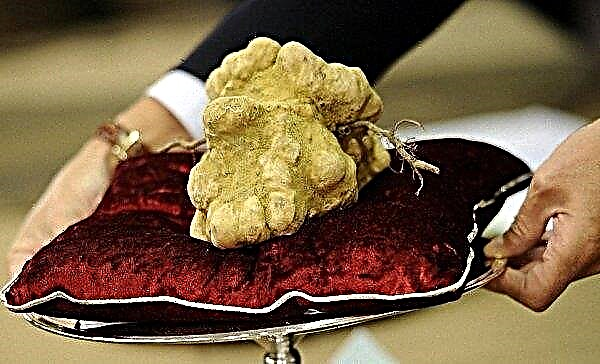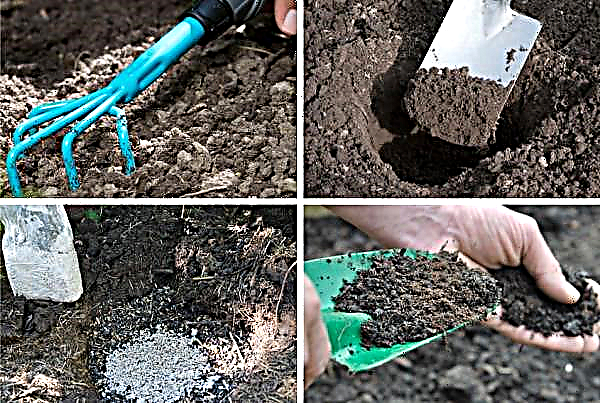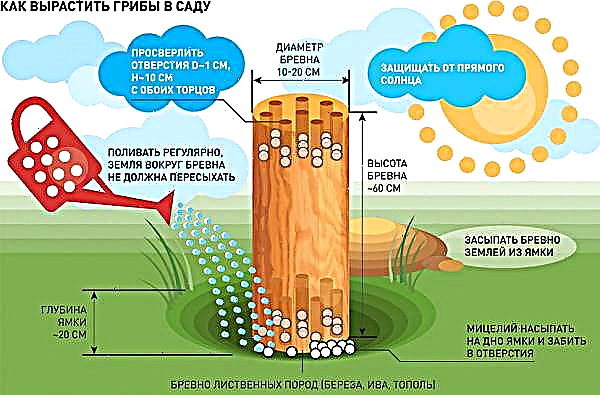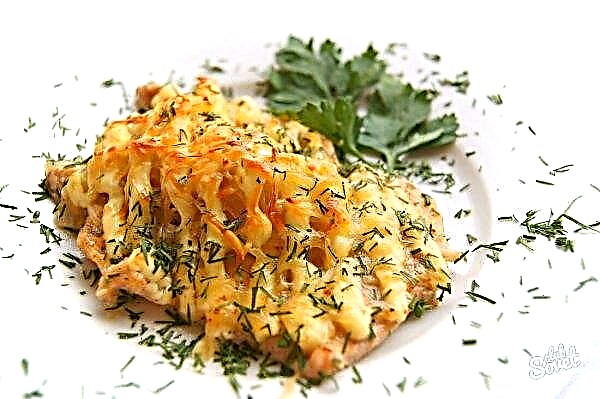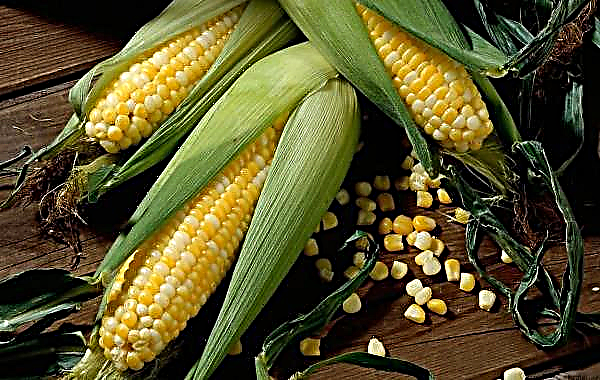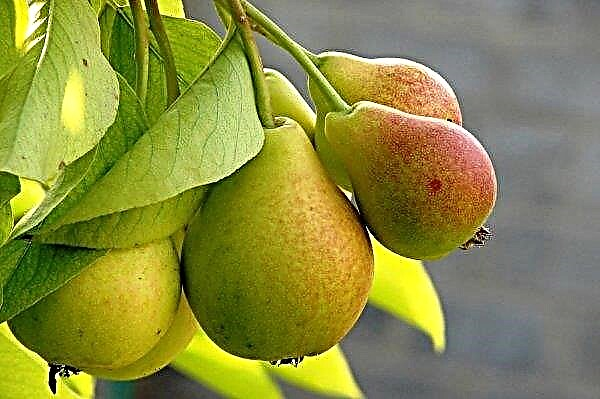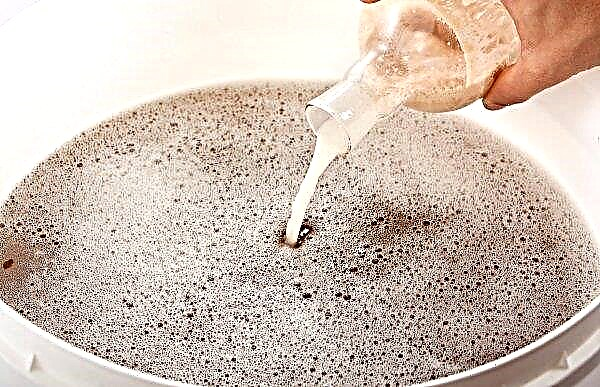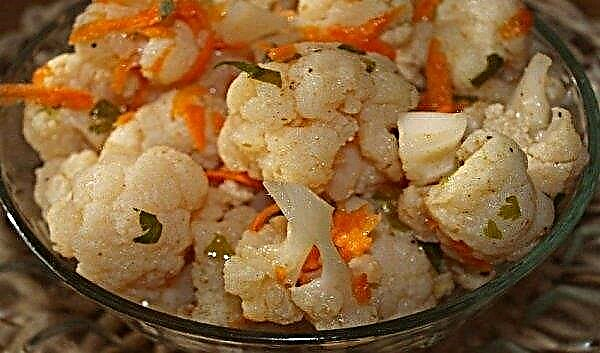The breed of the Yurlovsky vocalized chickens is popular for home keeping, as it is characterized by good productive indicators and the presence of many other features that attract most experienced poultry farmers. This article will examine detailed information about the bird, as well as the necessary conditions for its maintenance.
Breed description
The breed of the Yurlovsky vocalists was bred in Russia (Kursk region, the village of Yurlovo) more than 200 years ago. The breed was obtained by crossing local street chickens with individuals of heavy meat breed (presumably Brahma and Kokhinhin) and an unknown fighting breed.
Appearance
Consider the features of the appearance of representatives of the Yurlovskaya vocal, so that they can be identified among other breeds.
| Appearance | Description |
| Head | Large, wide, has large superciliary arches and small rounded red earrings. |
| Crest | Walnut, pink or leafy, bright red. |
| Beak | Powerful, elongated in width, short enough, yellow-black or brown. |
| Neck | Very long, located at an angle of 90 degrees to the body. |
| Chest | Well developed, extended in breadth, characterized by a rounded shape. |
| Stomach | Clearly defined, complete. |
| Wings | They have an average length, firmly pressed to the body. |
| Tail | Large, both in chickens and in roosters, strongly raised up, forms a right angle relative to the body. |
| Paws | Very long, strong, massive in appearance, yellow, brownish or orange. |
| Plumage and color | Poor plumage on the body and strongly feathered tail. The color is most often black with golden spots or a silver back. There are representatives of white-silver, salmon-red, black-red. |
Temperament
Representatives of the Yurlovskaya vociferous are very active and curious. Due to the fact that during the breeding process, individuals of fighting breeds were used, the Yurlovsky vocalists are distinguished by an aggressive, quick-tempered and impulsive character. They absolutely do not accept on their territory individuals of other breeds. Always this neighborhood ends in fights to the blood, reaching up to the death of the enemy, and not only roosters, but also hens are fighting.
Photo gallery
Advantages and disadvantages of the breed
- The main advantages of the breed are:
- large body weight with minimal bone weight;
- delicious dietary chicken meat;
- good egg production, large and tasty eggs;
- good reproduction and survival of chicks.
- The minuses of the breed include:
- aggressive nature;
- excessive voice;
- decrease in productive qualities with a constant content in a confined space.
Growing Yurlovskaya voiced breed at home
In order for chickens to be highly productive, healthy and active, they need to provide proper care and good conditions, so we will consider this information in more detail.
Conditions of detention
Depending on the time of the year and the age of the Yurlovsky vocal chickens, they need special conditions of detention.
Room requirements
In order for the birds not to suffer and develop normally, they need a fairly large space, so the house is equipped in such a way that 0.5 square meters are necessary for each individual. It is better to keep the roosters separate from the females, otherwise conflicts cannot be avoided. They must be placed in another enclosure at the age of 3 months.
The breed is not demanding on temperature conditions and normally tolerates wintering in the chicken coop without heating. Although it is noted that while maintaining the air temperature of +10 ... + 12 degrees in the winter, egg laying can be stimulated. In summer, the air temperature in the house should not be more than +25 degrees.Important! Despite the fact that some breeders prefer to keep young chickens in cages, individuals of this breed categorically do not tolerate space restrictions.
Exceeding temperature standards leads to an increase in the risk of poultry morbidity, the development of pathogenic bacteria in the litter and a decrease in immunity in birds. Also, high air temperatures can cause egg laying to stop. Young growth should be kept in a room with a temperature not lower than +25 degrees in both summer and winter. In winter it can be a heated room, without drafts.
 Humidity in the chicken coop is always high, but it is necessary to ensure that the indicators do not exceed 70%, since the risk of developing diseases also increases with increasing humidity.
Humidity in the chicken coop is always high, but it is necessary to ensure that the indicators do not exceed 70%, since the risk of developing diseases also increases with increasing humidity.
In the autumn-winter period, when the dawn comes late, and the sun sets early, it is recommended to turn on the lights in the early morning, and turn them off at a time when all the chickens are already in their places and ready for bed. Lighting for young animals is used as heating for birds, lamps are installed slightly lower than usual, while protecting with special shades.
Did you know? Chickens have good enough vision in daylight, but as soon as dusk sets in, the bird may not see the food that is in the feeders and remain hungry. If you turn off the light in the house before the hens take their places on the poles, they will remain on the floor until the morning.
Walking yard
Since Yurlovsky vocal chickens need free space, they need to provide a large walking yard. To do this, the territory near the chicken coop is fenced in such a way that the chickens could get into the room if desired. The area of the walking area should be at least two or three times larger than the premises in which the birds live. The fencing of the walking yard is carried out with a net, which must be buried in the ground by 20-30 cm in order to protect the bird from predators. For safety reasons, the walking yard should also be covered with a net on top. Young animals can be let out on a walking yard at the age of 1–1.5 months together with adult chickens, but at the same time make sure that they do not fight among themselves.
Young animals can be let out on a walking yard at the age of 1–1.5 months together with adult chickens, but at the same time make sure that they do not fight among themselves.
Feeding troughs and drinking bowls
Tanks for food and water must be located on the territory of the chicken coop and in the walking yard, so that hens have free access to food. Experienced breeders often make feeders on their own. To do this, use edged boards, constructing a capacity of about 13 centimeters in height, 25 cm in width. The length of the feeders depends on the number of individuals in the chicken coop, if the chickens are up to 20 pieces, then a single 110 cm long feeder will be sufficient.
Did you know? Chickens are very fond of taking baths, not just water, but ash-sand. In addition, such baths are very useful and allow the bird to get rid of parasites and clean feathers from pollution.
Water tanks can be metal, but at the same time they are well fixed so that the bird could not overturn them. For grass, a mesh bucket is placed in the chicken coop, through which hens independently pluck the leaves of the plants. It is hung on a hook near the wall, almost by the floor, so that the bird can easily eat.
For young animals, the same feeders and drinking bowls are installed, but the side should be 2 times less than with conventional tanks.
Feeding
Yurlovskie vocal, unlike other breeds of chickens, eat food in large volumes, therefore, are disadvantageous for industrial cultivation.  The diet of this breed practically does not differ from the usual diet of poultry, although there are some features, so we will consider them in more detail.
The diet of this breed practically does not differ from the usual diet of poultry, although there are some features, so we will consider them in more detail.
Chickens
For normal growth and development, chickens should eat enough food that contains animal protein. In addition, the process of feathering in chickens is quite slow, and in order to speed it up, it is necessary to give vitamins and foods with a high fat content to the bird.
After the chickens have hatched and completely dried, they are given a boiled egg, on the 3rd day of life, the diet is enriched with cereals, maggot, cottage cheese and minced meat. The second month of bird life is a time of intense growth. At this time, chickens must be provided with large amounts of food with vitamins and mineral supplements. The main food for young animals of this age is compound feed. In addition, greens and vegetables are added to the diet. Compound feed in this period should be 80% of the diet and 20% - a mash of vegetables with the addition of bran. Young animals can be given carrots, pumpkins, zucchini, cucumbers, fodder beets. The bird should eat 4 times a day - 3 times mixed feed and 1 time - a mash and greens.
The second month of bird life is a time of intense growth. At this time, chickens must be provided with large amounts of food with vitamins and mineral supplements. The main food for young animals of this age is compound feed. In addition, greens and vegetables are added to the diet. Compound feed in this period should be 80% of the diet and 20% - a mash of vegetables with the addition of bran. Young animals can be given carrots, pumpkins, zucchini, cucumbers, fodder beets. The bird should eat 4 times a day - 3 times mixed feed and 1 time - a mash and greens.
Adult chickens
The basis of the diet for adults are any cereals and legumes (peas and soybeans). About 150 g of grain must be fed per day. In winter, herbal flour is introduced into the diet and given twice a week, mixed with vegetables. A day, one chicken should receive at least 100 g of vegetables. Also, every day the bird must be provided with animal food: worms, maggot, fish, meat, cottage cheese.
In summer, the diet should consist of a large amount of fresh herbs (in parallel, reduce the amount of grain). All other components of the summer diet do not differ from the winter.Important! During egg laying, the amount of chalk and shells should be increased in the diet of the bird.

Shedding and egg laying break
Seasonal molting in this breed lasts for 3 months, during this period egg laying usually stops. No special measures need to be taken, the main thing is to provide the hens with high-quality and regular nutrition, as well as introduce additional minerals and vitamins into the diet.
Herd replacement planned
Chickens of this breed have a life expectancy of about 7 years, but they are recommended to be kept no more than 3 years, since the rest of the period they practically do not gain weight, which is not economically profitable. Send them to slaughter is recommended at the end of the productivity period, which is equal to two years. It is better to send roosters for slaughter at the age of one year - during this period they have maximum weight.
Possible bird diseases
The breed has a high natural resistance to disease, but nevertheless sometimes it can affect diseases such as:
- paratyphoid;
- Newcastle disease;
- arthritis.
Paratyphoid can be treated with several drugs:
- Tetracycline, which is used for a week, giving sick individuals 50 mg of the drug per liter of feed;
- Metapar, which is used in an amount of 10 g, diluting in 5 l of water. Sick individuals are given to drink every day like ordinary water.
 Arthritis is treated:
Arthritis is treated:- Polymexin M sulfate (50 mg per 1 kg of weight);
- Sulfadimethoxinum (100-200 mg per 1 kg of weight);
- Benzylpenicillin sodium or potassium salts (100 mg per 1 kg of body weight);
- Ampicillin (20 mg per 1 kg of body weight).

